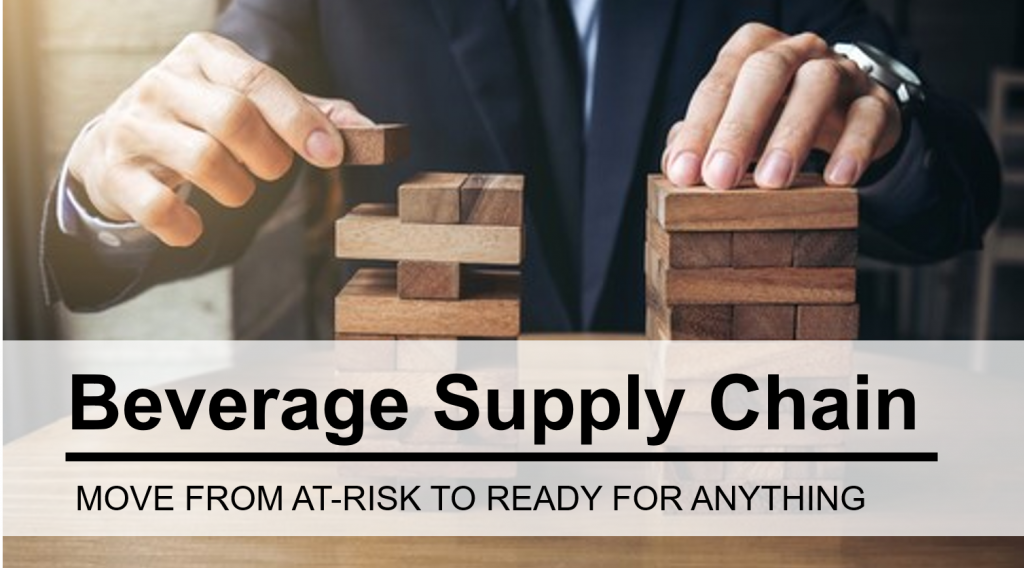Every beverage company depends on materials and services from other companies to produce, package and distribute their products. That dependence comes with risk. It’s not a matter of if, but when, something outside of your control will impact the cost and availability of materials you need to create your beverage. Trade negotiations, labor disputes, natural disasters, and food safety incidents are just a few of the potential sources of disruption to your supply chain. Just because you can’t predict what will happen next doesn’t mean you can’t be ready for it. Here is some advice to help you prepare to keep your beverage supply chain steady, no matter what lies ahead.
Keep an eye on your input.
Make sure you know not only the primary ingredients of your beverage but also the sub-ingredients and the sources of those ingredients. You need to know exactly what’s in your beverage, so you can track the news about how each item may be impacted by any situation. In the 2018 U.S.–China tariffs, the information can be confusing and its ever-changing as different items are being defined and added to, or dropped from, the official list and schedule. It’s important to note the different ways products are grouped and defined. For example, a particular sweetener may be included or excluded based on its classification as a “sugar alcohol.”
Imagine different beverage supply chain scenarios.
There are many factors that could affect the supply of your commodities including weather patterns, transportation issues, trade deals, and tariffs. On a more direct level, one of your key suppliers could face facility damage or contamination issues. It’s important to pay attention to what’s happening in the world and to have an understanding of the potential ways different scenarios could affect your beverage and your business. You should also think through what you would do if one of your primary suppliers could no longer work with you. The hope is that you won’t have to deal with the scenarios you’ve imagined, but intentionally thinking about them makes you aware of areas where you’re open to risk exposure and puts you in a better position to plan so you can react quickly if something happens.
Stay in contact with your suppliers.
The better your relationship is with your suppliers, the more information you’re likely to have about a situation that is unfolding or expected to impact business. It’s helpful to talk to suppliers often to ask about what they’re hearing and get a read on their plans to respond to potential changes in the market. Their answers and statements can give helpful clues about pricing implications or other factors that you can start planning for. Remember, when there is an issue with materials availability, it’s not only the cost but also timelines that can be impacted. Whether its time or cost increases, the more you know, the more you can prepare.
Know your risk tolerance and price sensitivity.
When the time comes to examine supply chain alternatives, you’ll want to know not only what your options are, but what decisions will best fit your company’s cash flow and risk tolerance. Can you afford to prebuy and warehouse materials to avoid potential higher prices? Are you willing to lock into a purchase agreement that commits you to a certain volume? Being willing to take on more risk, usually translates to better pricing and terms, but it’s important to stay within your comfort zone and not overextend your resources. These are difficult calls to make without an accurate picture of where you’re at today and a well-researched forecast for the future.
Consider locking in.
If you have the available resources and a supporting forecast, it might be a good idea to lock into some terms with your existing supplier to secure material ahead of tariff and market changes that impact your cost of goods. Review your stocking agreement with your supplier to see if they will allow you to purchase now and store the material for you to use as you need it. If you get the timing right, locking into a lower cost can save your company thousands of dollars.
Have a backup plan for your beverage supply chain.
It’s important to know what alternatives exist to your current ingredients in case you need to switch due to availability or cost. Is there another sweetener you could consider if one of your main sweeteners ends up on the tariffs list? Could you substitute a blend for a single ingredient if there was a cost increase? Know what alternatives you have to adjust your formulations and how they will affect the flavor and cost of your beverage. You should also have a list of alternative suppliers for your ingredients in different geographies and stay in contact with them in case you should need to make a switch based on an external situation.
A big part of ensuring your beverage is successful is taking control of your supply chain by staying informed, prepared, and engaged. BevSource specializes in building procurement and production plans that allow for growth and flexibility, while providing consistency in quality and product availability. Learn more at BevSource.


